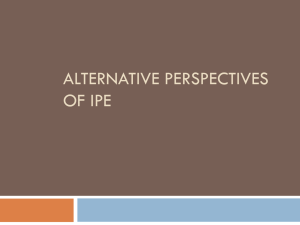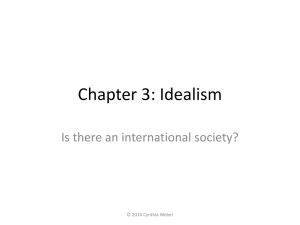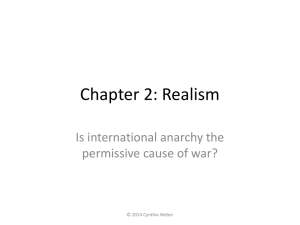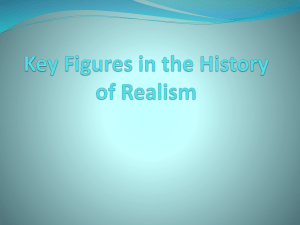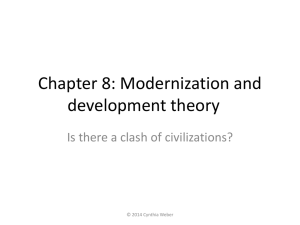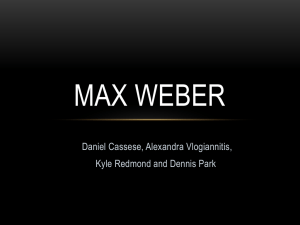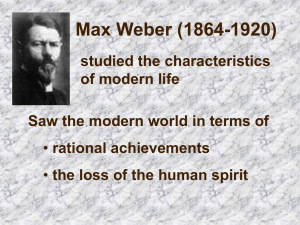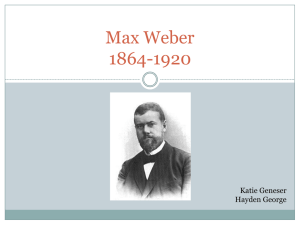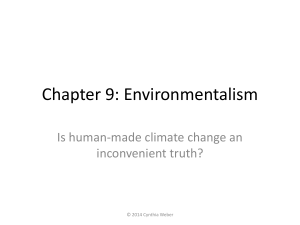Chapter 4: Constructivism
advertisement
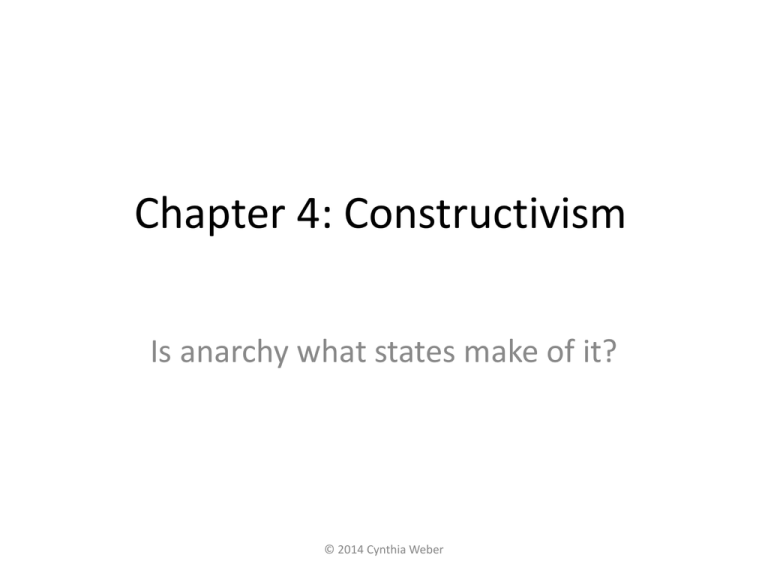
Chapter 4: Constructivism Is anarchy what states make of it? © 2014 Cynthia Weber Learning aims: Be able to identify how constructivism differs (and doesn’t) from realism and liberalism Understand the fundamental principles of constructivist social theory and what Wendt means when he claims that “international anarchy is what states make of it” To critically interrogate Wendt’s state-centric constructivism To critically engage with the advantages and disadvantages of Wendtian constructivism © 2014 Cynthia Weber Last week: Myth: “there is an international society” Key concepts: International society, communication, domestic analogy What appears to be international society may also just be US domestic society extended globally © 2014 Cynthia Weber Constructivism flashcard Key thinkers: Key concepts: Alexander Wendt & Nicholas G. Onuf Social construction Identities Practices Myth: “anarchy is what states make of it” © 2014 Cynthia Weber Three fundamental principles of constructivist social theory (box 4.2) 1. “People act toward objects, including other actors, on the basis of the meanings that the objects have for them” SOCIAL KNOWLEDGE 2. “The meanings in terms of which action is organized arise out of interaction” SOCIAL PRACTICE 3. “Identities [and interests] are produced in and through ‘situated activity’” IDENTITIES AND INTERESTS © 2014 Cynthia Weber Constructivism Wendtian constructivism No logic to anarchy Anarchy is an effect of practice “Anarchy is what states make of it” (Neo)realism Neoliberalism Logic of anarchy is structural and leads to conflict Logic of anarchy is a process that can lead to cooperation © 2014 Cynthia Weber Constructivism Table 4.2 Three stories of international anarchy Realism Idealism Constructivism Actors States States States Goals Survival Survival Survival Actors’ behavior in anarchy Increase power to Promoting social learning ensure survival through • Institutions (e.g. UN) • Ideas (e.g. democracy and liberal capitalism) Unpredictable prior to social interaction What mitigates state behavior? Self help because • No world government (anarchy) • Cooperation among states unreliable International society Intersubjectively constituted structure of identities and interests • If state identities and interests produced as competitive competition • If state identities and interests produced as cooperative cooperation Logic of anarchy Conflictual Cooperative Anarchy is what states make of it © 2014 Cynthia Weber Advantages and disadvantages of Wendtian compromise Table 4.5 Advantages and disadvantages of the Wendtian compromise Advantages Disadvantages Can hold states accountable for their part in producing anarchy as either conflictual or cooperative • Cannot escape reification because Wendt replaces a reified logic of anarchy with reified states • Misses the opportunity to restore a broad focus on process and practice in international politics because Wendt must exclude from consideration the practices that produce states as products of anarchy in order for his myth to function © 2014 Cynthia Weber Theory activity: Rationalism, reflectivism and the politics of bridge building • Aim: To think critically about Wendt’s aims at bridge building and what it means for the reflectivist critique • Answer the following question in groups (7 min.) – What is rationalism and reflectivism? – How does Wendtian constructivism attempt to build a bridge between rationalism and reflectivism? • Either as whole group or in smaller groups discuss the following (7 min.): – What are the politics of Wendt’s move? – What does this move mean for rationalism and reflectivism respectively? – Is it really possible to bridge two traditions? © 2014 Cynthiathese Weber Theory activity: What is wrong with rationalism? (box 4.1) 1. Rationalism takes the identities and interests of states as given because it only recognizes changes in states’ behavior but not in states themselves (i.e. their identities and interests) 2. Rationalism also takes the identities of and the interests generated from international anarchy as given. For rationalists, neither the structure of international anarchy nor the self-help system is said to produce can be changed © 2014 Cynthia Weber 3. Overall, rationalism limits theoretical understandings of change in agents and structure because it only examines changes in behavior and excludes an examination changes in identities and interests What seems to be typical and deviant in the world of Wag the Dog (table 4.3) Typical Deviant For the tail (spin doctors and policy-makers) to wag the dog (the US public For the dog (the US public) to wag its tail (spin doctors and policy-makers) © 2014 Cynthia Weber Reconsidering what is typical and deviant in the world of Wag the Dog Typical Deviant For the tale (mediatic practices) to wag the tail (producers/spin doctors) so that it appears that the tail (producers) wags the dog (US public) Either: For the dog (US public) to wag its tail (producers/ spin doctors/policy-makers) Or For the tail (producers/ spin doctors/ policy-makers) to “really” wag the dog (US public) without being wagged by the tale (mediatic practices) itself © 2014 Cynthia Weber Production and seduction in Wag the Dog Connie: You can’t do it Stanley: [angrily] Don’t you tell me that. Don’t you ever tell me that. I’m the producer of this show. [looks out the window at the set where the patriotic funeral for the returned war hero is being shot] Look at that. That is a complete fucking fraud, and it looks one hundred percent real. [contemplatively, softly] It’s the best work I’ve ever done in my whole life, because it’s so honest…[insistently] I tell you, for once in my life I will not be pissed on. I want…I want the credit. I want the credit (Wag the Dog) “Seduction doesn’t just tease us into wanting what we cannot see. It convinces us that there is something there to be seen” (Weber, 2013) ‘The tale itself tricks us into thinking that there is an author of the tale’ (Weber, 2013) © 2014 Cynthia Weber Film activity: Updating Wag the Dog Aim: Think about how the role of authorship, seduction, production and the media might have changed from 1997 to today Task 1: In small groups come up with a basic film plot which updates Wag the Dog to today considering the following (7 min.): 1.Could the role of the producer be the same today as in 1997? 2.What in the plot would need to change and what could be kept for it to make sense today? 3.Which characters could you keep and who would need to be added? 1.With the changes you have made to your movie, how does this affect the role of authorship and seduction? Task 2: Either in small groups or together discuss the following questions (7 min.): 2.Who would take the role of the producer (Stanley in Wag the Dog) in your film? 3.Consider the statement: “Seduction doesn't just tease us into wanting what we cannot see. It convinces us that there is something there to be seen” (Weber, 2013). Is this more or less true in your film (today) than in Wag the Dog (1997)? © 2014 Cynthia Weber Next week: Gender Feminisms place in IR Film: Femininity Fatal Attraction Masculinity Is gender a variable? © 2014 Cynthia Weber
